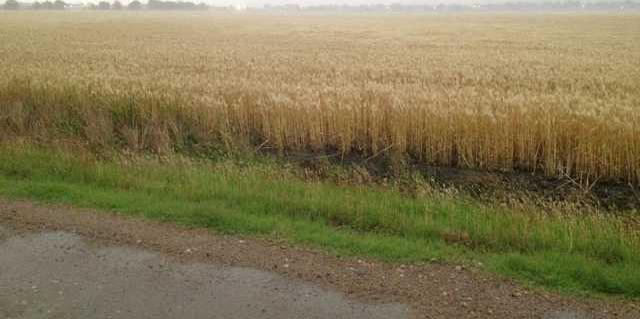What a difference a year makes. This time last year, Barton County farmers were wrapping up the 2012 wheat harvest, and everyone, farmers and non-farmers alike, were praying for rain.
The Barton County wheat harvest should begin this week, around June 21, said Alicia Boor, Barton County Ag Extension Agent. Drought stricken wheat will start a few days earlier, depending on the heat and where recent rains fell.
“We’re late this year, but not too late,” Boor said. “Last year was extremely early, but that’s because the temperatures were never too cool.” This year, three freezes in April and early May plus the cooler weather pushed everything back. The freezes did not have as much an effect as many anticipated. The moisture that came with each freeze helped to insulate the plants and hold warmth in the soil, she said. While there are spots where wheat has turned white in some fields, drought is the more likely culprit.
Where rain has fallen, the quality of the wheat crop will be really good. Some places, especially irrigated wheat and seed wheat plots, could have as much as 70 bushels. An average harvest will produce mostly 30-40 bushels per acre, with some 50-60 acres. However, out west where rain was less plentiful, some wheat is shriveled and shrunken out west. Some have heads that never filled. It depends on rain.
One positive that has come from the past dryness is less disease pressure this year. Because of this, far fewer producers are finding mosaic, as well as insects which are either experiencing smaller populations or the plants weren’t at the right stage for attack, thanks to the late growing season.
“At least we’ll have a wheat crop,” Boor said. “At least its starting to look like farmers can make a living farming again.”
Corn and Beans
As the wheat harvest kicks into gear, eyes turn to the upcoming corn and soybean crops. Both are looking good right now. Boor said even dryland corn is looking good right now thanks to the rain the area has received in previous weeks. However, as the heat builds, that rain will need to continue to come.
“If we don’t get more rain, next week it could start to go downhill,” she said. “It’s a waiting game now.”
To keep things going, during a normal summer with normal summer temperatures, we need to get 22-30 inches of water from planting to maturity to make the corn crop thrive. So far this year, we’ve experienced average rainfall, but not in the last few years. While we don’t need that much in rain, depleted soil moisture means irrigation or rain will be needed in a timely fashion.
“We still need a couple of good rains to maintain good soil moisture levels and it evaporates every day,” she said. “At least as of this last Monday, we were still ok in the moisture department.”
Pasture crops
Typically, July and August are the hottest, driest months of the year in this region, so it’s hard to tell what will happen. While hay and alfalfa also appear to be holding their own, looking good, they are still affected by previous years’ droughts.
Recently, Boor was taking field soil samples in the county. This requires her to drill down 24 inches into the ground. The first few inches were fine, but after 12-18 inches, it was like concrete, she said.
This differs from hard pan or tillage pan that farmers often encounter. Hard pan is caused by working the soil while it is wet, resulting in a hard, concrete like layer at the depth of the implements used. In laymans terms, hard pans don’t allow moisture or roots through easily where drought is just soil without water in it, according to Boor.
“You would burn through an entire power drill battery pack going for one sample in places.”
Boor anticipates drought affecting the area at least through this year, after keeping a sharp eye on the drought monitor. While the degree of drought is lessening, Barton County and the surrounding area isn’t out of the woods yet.
“The pastures are trying to come back, but they are so tender right now, and the weeds are so opportunistic, that if we don’t back off and treat them like we’re still in that heavy hot drought, you can kill off your whole pasture,” she said.
If this is the beginning of the end of the drought, a full turnaround could take at least five years. This period of drought has been compared to the 1930s in severity.
Web resource:
Hard pan vs. drought: http://www.ksre.ksu.edu/bookstore/pubs/AF115.pdf
Wheat harvest gearing up throughout area





